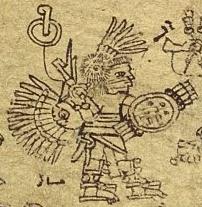
Codex Xolotl
Encyclopedia

Aztec codices
Aztec codices are books written by pre-Columbian and colonial-era Aztecs. These codices provide some of the best primary sources for Aztec culture....
, thought to have originated before 1542. It is annotated in Nahuatl
Nahuatl
Nahuatl is thought to mean "a good, clear sound" This language name has several spellings, among them náhuatl , Naoatl, Nauatl, Nahuatl, Nawatl. In a back formation from the name of the language, the ethnic group of Nahuatl speakers are called Nahua...
and details the preconquest history of the Valley of Mexico
Valley of Mexico
The Valley of Mexico is a highlands plateau in central Mexico roughly coterminous with the present-day Distrito Federal and the eastern half of the State of Mexico. Surrounded by mountains and volcanoes, the Valley of Mexico was a centre for several pre-Columbian civilizations, including...
, and Texcoco in particular, from the arrival of the Chichimeca
Chichimeca
Chichimeca was the name that the Nahua peoples of Mexico generically applied to a wide range of semi-nomadic peoples who inhabited the north of modern-day Mexico and southwestern United States, and carried the same sense as the European term "barbarian"...
under the ruler Xolotl in the year 5 Flint
Aztec calendar
The Aztec calendar is the calendar system that was used by the Aztecs as well as other Pre-Columbian peoples of central Mexico. It is one of the Mesoamerican calendars, sharing the basic structure of calendars from throughout ancient Mesoamerica....
(1224) to the Tepanec War in 1427. The codex describes Xolotl's and the Chichimeca's entry to the, at the time, unpopulated valley as peaceful. Although this picture is confirmed by the Novahispanic
New Spain
New Spain, formally called the Viceroyalty of New Spain , was a viceroyalty of the Spanish colonial empire, comprising primarily territories in what was known then as 'América Septentrional' or North America. Its capital was Mexico City, formerly Tenochtitlan, capital of the Aztec Empire...
historian Fernando de Alva Cortés Ixtlilxochitl
Fernando de Alva Cortés Ixtlilxochitl
Fernando de Alva Cortés Ixtlilxóchitl was a Novohispanic historian.-Life:A Castizo born between 1568 and 1580, Alva Cortés Ixtlilxóchitl was a direct descendant of Ixtlilxochitl I and Ixtlilxochitl II, who had been tlatoque of Texcoco...
(1568 or 1580–1648), there is other evidence that suggests that the area was inhabited by the Toltec
Toltec
The Toltec culture is an archaeological Mesoamerican culture that dominated a state centered in Tula, Hidalgo in the early post-classic period of Mesoamerican chronology...
s.
Ixtlilxochitl, a direct descendant of Ixtlilxochitl I
Ixtlilxochitl I
Ixtlilxochitl Ome Tochtli was the ruler of the Acolhua city-state of Texcoco from 1409 to 1418 and the father of the famous "poet-king" Nezahualcoyotl.-Early years as tlatoani:...
and Ixtlilxochitl II
Ixtlilxochitl II
Ixtlilxochitl II was the son of Nezahualpilli, king of Texcoco. In 1516 Nezahualpilli died, and the succession was contested by two of his sons, Cacamatzin and Ixtlilxochitl...
, based much of his writings on the documents which he most probably obtained from relatives in Texcoco or Teotihuacan
Teotihuacan
Teotihuacan – also written Teotihuacán, with a Spanish orthographic accent on the last syllable – is an enormous archaeological site in the Basin of Mexico, just 30 miles northeast of Mexico City, containing some of the largest pyramidal structures built in the pre-Columbian Americas...
. The codex was first brought to Europe in 1840 by the French scientist Joseph Marius Alexis Aubin, and is currently held by the Bibliothèque nationale de France
Bibliothèque nationale de France
The is the National Library of France, located in Paris. It is intended to be the repository of all that is published in France. The current president of the library is Bruno Racine.-History:...
in Paris
Paris
Paris is the capital and largest city in France, situated on the river Seine, in northern France, at the heart of the Île-de-France region...
.
The manuscript consists of six amatl
Amatl
Amate is a form of paper that has been manufactured in Mexico since the pre Hispanic times. Amate paper was extensively produced and used for both communication, records and ritual during the Aztec Empire; however, after the Spanish conquest, its production was mostly banned and replaced by...
boards measuring 42 ×, with ten pages and three fragments from one or more pages. While it is unknown who did the binding of the manuscript, it is cast like a European book back to back. The Codex Xolotl has been an important source in giving detailed information on material, social, political and cultural changes in the region during the period. It is one of the few still surviving cartographic histories from the Valley of Mexico and one of the earliest of its type.

